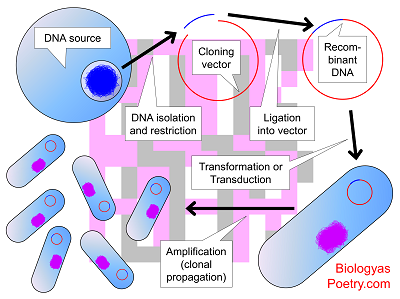∞ generated and posted on 2016.08.28 ∞
Means of increasing the copy number as well as mediating the controlled expression of DNA sequences, done by inserting those sequences, in association with vectors, into living cells.
The product of gene cloning is creation of a clone. A clone is equivalent to a clone in a more general sense, that is, an organism and descendants that have propagated asexually, with the major difference being that in this case the clone has been generated by gene cloning so also is a recombinant organism carrying recombinant DNA.
See also polymerase chain reaction.

Figure legend: Gene cloning begins with isolation of DNA from some source, purifying that DNA, and then in some manner creating smaller pieces of DNA. This can be via shearing or instead can involve more precise cutting using restriction endonucleases, a.k.a., restriction enzymes. The resulting piece of DNA is then “ligated” into a cloning vector, where ligation is just as occurs during DNA replication, i.e., it is the repairing of gaps in the DNA backbone. The resulting recombinant DNA, consisting of vector DNA in combination with the to-be-cloned piece of DNA is then inserted into a cell. Here a bacterial cell is shown, such as E. coli. The process of inserting of this DNA involves either transformation, which is the inserting of naked DNA into a cell, or instead transduction which is the inserting of virus-associated DNA into a cell. Once present within the target cell, that cell is referred to as a transformant. Allowing these cells to replicate results in an amplification of the now-cloned DNA. Using what are known as expression vectors allows the gene expression of cloned DNA such as to produce protein products which then can be studied and/or used to do useful things, such as serving as drugs.
The steps involved in gene cloning are fairly consistent, entailing:
(1) Either isolation or generation of to-be-cloned DNA
(2) Cleaning up of that DNA (purification)
(3) Cutting of that DNA, typically but always using restriction enzymes
(4) Insertion of the cut DNA into a cloning vector
(5) Insertion of the cloning vector into a host organism (such as into E. coli
(6) Identification of the clone carrying the desired DNA
(7) Further characterization, subcloning, sequencing, gene expression, etc.
See also genomic library.